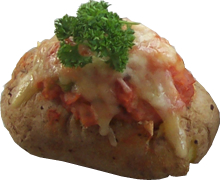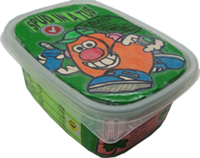Spud in a Tub
 Sarah Angove
Sarah Angove
Tararua College
Year 11 Food Technology, 14 weeks project
The class was given a context in which to develop their project called the Lunch Box. After looking at the broad key factors related to key trends, the obesity issue and current market products for lunch box fillers the students identified an issue they wished to explore. Sarah chose to investigate developing a product suited to people who take their lunch to work which was low in fat, salt and sugar.
Sarah started by gathering a small focus group which reflected her target market and developed questions about what products they liked on the market at the moment and what type of product may suit their needs. Their feedback at this point was enough for her to decide to develop a stuffed baked potato product that could meet their needs. To start developing concepts on flavours Sarah surveyed her focus group for types of ingredients they would consider suitable for the product. She used this information collated to develop pie and bar graphs to display the survey results and was able to use these results to draw conclusions and plan what she needed to do next.
Sarah trialled a lot of different flavours, with continual feedback from her focus group to refine her ideas to only a few. As she developed these flavours she was investigating further into the most suitable type of potato to use, storage and reheating tests and packaging concepts.
Sarah used a variety of sensory tests to gain feedback including sensory descriptors hedonic scale of liking and ranking tests. As the product development continued Sarsh decided to put added value into her product by using Omega 3. This idea came form the activities the class had done related to the "Cookie Time Smart Cookie" and issues identified related to nutrition. She decided to try Omega 3 tablets and then she trialled the fish oil with Omega 3. She was able to add enough Omega 3 to one potato that was half the daily required intake for an adult without the focus group detecting the fishy flavour. It was good to see that Sarah also took into consideration others sources of Omega 3 such as walnuts and flax seed oil but discounted these related to allergen problems and cost factors.
Sarah's final product was in fact a stuffed baked potato with a pizza flavour. The texture after freezing and reheating were unaffected. In fact the taste of the potato was just what you would expect from a pizza. When Sarah presented her final product she had developed a model for the packaging and label of the product.
Sarah's strengths in her Technological Practice were her investigative research – looking at potatoes varieties and cooking and freezing properties as well as Omega 3; planning – the modelling of a package and label conceptual design was proof of excellent planning to manage her time and resources in the constraint of time given. She used a variety of planning tools from a Gantt chart, a term planner, checklists lists, as well as planning in detail and then reviewing and reflecting on her work and developing key decisions from this; and lastly techniques to get focus group feedback with the use of surveys and sensory test sheets.
 Giving her product added value with Omega 3, ensuring she used ingredients tolower fat and salt levels, refining her product sensory attributes and testing the fitness for purpose related to freezing and reheating the product all contributed to this project being a good example of Food Technology. It is just a pity the "Spud in a Tub" is not in the supermarket freezers for everyone to try!
Giving her product added value with Omega 3, ensuring she used ingredients tolower fat and salt levels, refining her product sensory attributes and testing the fitness for purpose related to freezing and reheating the product all contributed to this project being a good example of Food Technology. It is just a pity the "Spud in a Tub" is not in the supermarket freezers for everyone to try!

